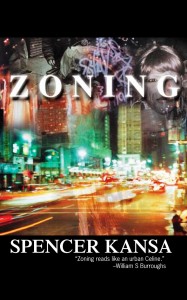Zoning, by Spencer Kansa, Beatdom Books, 2011 – $12.00 – paper
Spencer Kansa’s debut novella Zoning is terrifying, page-turning fun. If this seems contradictory, consider that he was an acolyte of William Burroughs, so gallows humor grotesque enough to rival the Master himself is no stranger here in Kansa’s printscape.
The good word is that Kansa has enough of his own voice to break new ground. The book is a collage of fictionalized autobiography, diary entries, cultural reportage, girlie mag sex stories (decidedly hetero here) and a well-mapped delirium from territories of acid visions, opiate dreams, and occult scrying. As such, it generally avoids the pastiche of lesser Burroughs aficionados, because these read as REAL experiences. It also avoids what inferior pretenders of the Burroughs view often miss–it is not mean. Characters, however flawed, are not treated with contempt, but examined with a “scientific nerve” as Allen Ginsberg referred to Burroughs view of life. That is to say, they are recognized.

Zoning has a plot, and whenever you begin wondering where the story is going, rather than offering a plot point from the standard 3-act narrative, Kansa quite literally changes the channel. He gets away with it, only to switch back to a recognizable time-space with the same characters when you least expect it. These characters are primarily Astral Boy and the Skyline Kid, who seem to strike a general Herman Hesse dichotomy of one individual, presumably mostly Kansa himself: both as a feral street boy just as comfortable in a pack as on his own and a withdrawn effete intellectual. But this is not merely an old school Dionysus and Apollo yin yang – the main difference between them is mind training. Skyline Kid has raw energy with potential, while Astral Boy has disciplined that energy. Still, they, like everything else, continually blur together. As to what the plot behind their shenanigans is, well, no sooner do you think you know when that channel is changed yet again. Pawns of psychic research, UFOlogy, scoring a fix, getting an orgasm, and just trying to survive are roles that are worn like new cybergoth outfits. Eventually, it all gets scrubbed away.
In fact, one of the more successful aspects of the book is the way that dreams, visions, drugs and conventional reality all seem equally weighted. Consciousness beyond the body is less of a theory than a repeatable experience. This is a philosophy, not a holiday. Don’t ask if it’s real, ask if there is such a thing. “Kamikaze” is the word Kansa uses, and I must admit, as an older reader nearly 60 with addiction and two mental wards behind me, the adventures of hooligans risking their sanity is far more hair-raising than watching a skate punk plummet into traffic. No spoiler – one of our main characters doesn’t land on his feet.
Consider that the publication of Zoning follows Kansa’s own well-researched Wormwood Star: The Magickal Life of Marjorie Cameron (Mandrake Press), a groundbreaking first bio of an important occult/Beat artist. Kansa rescues her from astonishingly unfair obscurity, dead shortly before Ginsberg and Burroughs shuffled off. You will begin to recognize Kansa’s familiar obsessions in Zoning. Still, Zoning is a work that Burroughs lived long enough to praise (his quote: “Zoning reads like an urban Celine.”), which means it was actually finished before 1997, a good 15 years ago.
With the advent of the e-book and its print-on-demanded counterpart, we enter the garage band equivalent of the late 1970s – deja vu all over again to quote Berra the Yogi. Beatdom Books heralds this Zoning debut, but the days of a publishing company are in delightful decline. It means what it meant for punk rock – fuck those overproduced big studio albums. This planet cannot afford to cut down any more trees to finance some wealthy conservative editor’s summer palace. Can the liberation of film be far behind? How many tepid bondage best sellers and blockbuster films about cartoons do we need? Why should voices like Kansa’s be held captive by profit margins? The lack of a big buck editor does occasionally show, as in a sentence that seems unaware that “seductively” has just been used twice. But wouldn’t you rather hear a random cough on the musical take that a streamlined sanitized end product?
PostBeat writing is not nostalgia, as its detractors would have us believe. It continues the Beat attention to mind’s spontaneous movement with the fundamental desire to cut through all conditioning. It also contains, at best, empathy – or again that word “recognition” – especially in regards to the disenfranchised and the underdog , often inclusive of sentience itself (Buddhism permeated most of the Beats, even if not fully embraced) Certainly Kansa shows much of this. He is not a Buddhist, but he is interested in Buddhism’s tools.
Those familiar with Burroughs’ writing will recognize the homage in a line like “FLASH CUT: fragments of torn childhood photographs flutter across a wasteland.” But Kansa proves himself an original from the imagistic origins of Beat: “…the red, neon streets glowing like molten lava through the cracks of the city.” Or “The sidewalks, fresh from recent rain showers, glistened under the orange haze of streetlights…” Yes, at times there is pastiche, Tarantino-like in Kansa’s worship of Old Bill. But Burroughs first imitated Hammett, Kerouac mimicked Thomas Wolfe, and Ginsberg was all over the poetic map before Williams and Kerouac set him right – and their own echoes remained with him ‘til Ginsberg’s death.
Zoning is above all, satisfying. That says enough, and it says a lot.
—Marc Olmsted
Essays Reviews